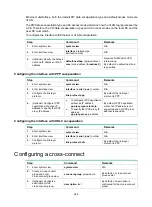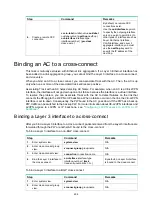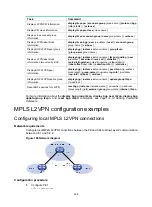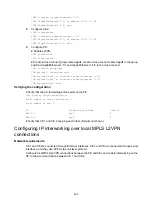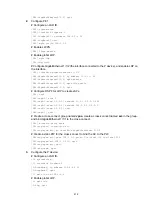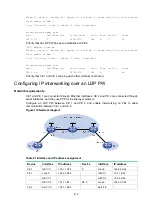
406
Configuring LDP PW redundancy
Step Command
Remarks
1.
Enter system view.
system-view
N/A
2.
Enter cross-connect group
view.
xconnect-group
group-name
N/A
3.
Enter cross-connect view.
connection
connection-name
N/A
4.
(Optional.) Specify the
switchover mode and set the
wait time for the switchover.
revertive
{
wtr
wtr-time
|
never
}
By default, the switchover mode is
revertive and the switchover wait
time is 0 seconds.
5.
Configure the dual receive
feature for PW redundancy.
protection dual-receive
By default, the dual receive
feature is disabled. When the
primary PW is normal, the backup
PW does not send or receive
packets.
6.
Enter cross-connect PW
view.
peer
ip-address
pw-id
pw-id
[
pw-class
class-name
|
tunnel-policy
tunnel-policy-name
] *
N/A
7.
Configure a backup LDP PW
and enter backup
cross-connect PW view.
backup-peer
ip-address
pw-id
pw-id
[
pw-class
class-name
|
tunnel-policy
tunnel-policy-name
] *
By default, no backup LDP PW
exists.
8.
Return to user view.
return
N/A
9.
Manually switch traffic to the
backup PW of the specified
PW.
l2vpn switchover peer
ip-address
pw-id
pw-id
N/A
Configuring interworking for a cross-connect
Interworking enables a PW to connect ACs that have different link types, including FR, HDLC,
Ethernet, and PPP. In an IPv4 interworking scenario, a PE extracts IPv4 packets from frames
received from the AC and sends the packets to the peer PE through the PW. The peer PE uses the
link protocol of the connected AC to encapsulate the IPv4 packets, and sends the packets through
the AC. This method hides the link types of ACs at the two ends.
To configure MPLS L2VPN interworking, follow these restrictions and guidelines:
•
When a CE is connected to a PE through an Ethernet or VLAN link:
{
On the Ethernet network or in the VLAN, the CE and PE must be the only Layer 3 network
devices.
{
On the PE's interface connected to the CE, use the
default-nexthop
command to configure
the default next hop address. This allows the PE to correctly encapsulate a link layer header
for packets destined for the CE.
−
If you specify the unicast MAC address (the MAC address of the CE) or a broadcast
MAC address as the default next hop, the PE uses the MAC address as the destination
address of the outgoing packets.
−
If you specify the IP address of the CE as the default next hop, the PE resolves the IP
address to a MAC address through gratuitous ARP, and then uses the resolved MAC
address as the destination MAC address of the outgoing packets.
{
After you enable interworking for a cross-connect, the PE responds to all ARP requests
from the CE with its own MAC address. After you disable interworking on the PE, you must








